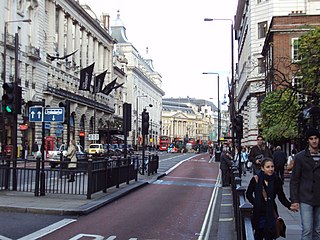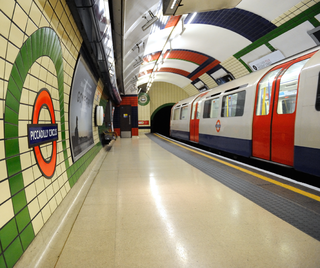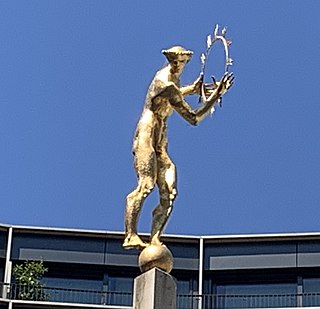
In ancient Greek religion and mythology, Helios is the god who personifies the Sun. His name is also Latinized as Helius, and he is often given the epithets Hyperion and Phaethon. Helios is often depicted in art with a radiant crown and driving a horse-drawn chariot through the sky. He was a guardian of oaths and also the god of sight. Though Helios was a relatively minor deity in Classical Greece, his worship grew more prominent in late antiquity thanks to his identification with several major solar divinities of the Roman period, particularly Apollo and Sol. The Roman Emperor Julian made Helios the central divinity of his short-lived revival of traditional Roman religious practices in the 4th century AD.

In Greek mythology, the Charites, singular Charis, or Graces, were three or more goddesses of charm, beauty, nature, human creativity, goodwill, and fertility. Hesiod names three – Aglaea ("Shining"), Euphrosyne ("Joy"), and Thalia ("Blooming") – and names Aglaea as the youngest and the wife of Hephaestus. In Roman mythology they were known as the Gratiae, the "Graces". Some sources use the appellation "Charis" as the name of one of the Charites, and equate her with Aglaea, as she too is referred to as the wife of Hephaestus.

Piccadilly is a road in the City of Westminster, London, England, to the south of Mayfair, between Hyde Park Corner in the west and Piccadilly Circus in the east. It is part of the A4 road that connects central London to Hammersmith, Earl's Court, Heathrow Airport and the M4 motorway westward. St James's is to the south of the eastern section, while the western section is built up only on the northern side. Piccadilly is just under 1 mile (1.6 km) in length, and it is one of the widest and straightest streets in central London.

Piccadilly Circus is a road junction and public space of London's West End in the City of Westminster. It was built in 1819 to connect Regent Street with Piccadilly. In this context, a circus, from the Latin word meaning "circle", is a round open space at a street junction.

Piccadilly Circus is a London Underground station located directly beneath Piccadilly Circus itself, with entrances at every corner. Located in Travel-card Zone 1, the station is on the Piccadilly line between Green Park and Leicester Square and on the Bakerloo line between Charing Cross and Oxford Circus.

Haymarket is a street in the St James's area of the City of Westminster, London. It runs from Piccadilly Circus in the north to Pall Mall at the southern end. Located on the street are the Theatre Royal, His Majesty's Theatre, New Zealand House, a cinema complex and restaurants.

A quadriga is a car or chariot drawn by four horses abreast and favoured for chariot racing in Classical Antiquity and the Roman Empire. The word derives from the Latin quadrigae, a contraction of quadriiugae, from quadri-: four, and iugum: yoke. In Latin the word quadrigae is almost always used in the plural and usually refers to the team of four horses rather than the chariot they pull. In Greek, a four-horse chariot was known as τέθριππον téthrippon.

The Criterion Theatre is a West End theatre at Piccadilly Circus in the City of Westminster, and is a Grade II* listed building. It has a seating capacity of 588.

Piccadilly Gardens is a green space in Manchester city centre, England, on the edge of the Northern Quarter.

Coventry Street is a short street in the West End of London, connecting Piccadilly Circus to Leicester Square. Part of the street is a section of the A4, a major road through London. It is named after the politician Henry Coventry, secretary of state to Charles II.

The Haymarket Shopping Centre is a shopping centre in the city centre of Leicester, England. It was opened on 4 June 1973 as part of the Haymarket Centre and was the country's second shopping centre after the Bull Ring, Birmingham. It is located east of and adjacent to the Clock Tower.

In ancient Greek religion and mythology, Euphrosyne, is a goddess, one of the three Charites, known in ancient Rome as the Gratiae (Graces). She was sometimes called Euthymia or Eutychia.

In Greek mythology, Thalia or Thaleia was one of the three Charites or Graces, along with her sisters Aglaea and Euphrosyne.

The Shaftesbury Memorial Fountain, officially and popularly known as Eros, is a fountain surmounted by a winged statue of Anteros, located at the southeastern side of Piccadilly Circus in London, England. Moved after the Second World War from its original position in the centre of the circus, it was erected in 1892–93 to commemorate the philanthropic works of The 7th Earl of Shaftesbury, the Victorian politician and philanthropist, and his achievement in replacing child labour with school education. The fountain overlooks the south-west end of Shaftesbury Avenue, also named after the Earl.

Guy Portelli is a contemporary British sculptor.

Farewell to Orpheus is an outdoor 1968–1973 bronze sculpture and fountain by Frederic Littman, installed at the Portland State University campus in Portland, Oregon, United States.

Horse and Rider is a 1974 bronze equestrian sculpture by Elisabeth Frink. The work was commissioned for a site in Mayfair; another cast is in Winchester. It was described by Frink as "an ageless symbol of man and horse".

The Poets' Fountain was a public fountain with sculptures that was installed on a traffic island in Park Lane, London, in 1875. It was removed in 1948 and it is thought to have been destroyed. One sculpture, an allegorical figure of Fame, is known to have survived and is displayed in the gardens at Renishaw Hall in Derbyshire.

Helios is a three-metre high bronze, gilded sculpture created by T. B. Huxley-Jones in 1960, located at Television Centre in London, part of the Helios Building, a listed Building in White City. The statue was restored and returned to the site in 2017.






















